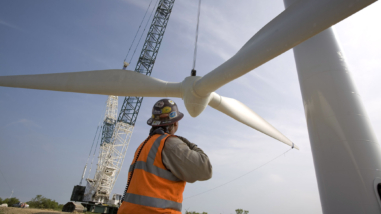Environment Program Request for Proposal: Aligning Passive Investment with Paris Climate Goals
Note: As a response to COVID-19 delays, our new deadline for RFP submission is April 24th, 2020 by 11:59 PM PST.
The purpose of this Request for Proposal (RFP) is to generate ideas and fund solutions that address climate change problems associated with the current state of passive asset management, where a fund’s portfolio mirrors a market index that is not low-carbon. In 2019, the Hewlett Foundation issued a new climate finance strategy, which has a charitable goal to activate climate solutions through innovative finance and the systemic decarbonization of capital, from consumers to corporate financial institutions. Specifically, the Hewlett Foundation aims to support the development of robust environmental, social and governance (ESG)-driven, climate-friendly passive funds and efforts that remove climate change causing investments from products. We seek to expand the levers by which our funding recipients can shift passive investment capital into climate solutions. The goal here is not to shift passive management to active management, or vice versa, but rather to ensure that passive management is aligned with decarbonization.
Current State of Passive Asset Management
On September 18, 2019, for the first time passively managed U.S. equity funds overtook their actively managed counterparts. This was the culmination of a multi-decade trend that is inextricably intertwined with the consolidation in the asset management industry. As asset managers get larger and more concentrated, and increasingly drive customer investment into low-fee, broad-based passively managed index or exchange traded fund (ETFs) products, this trend is expected to keep growing.
The rise of passive investing is not confined to the United States. European equity markets are now approximately 33% passive and Asian equity markets about 50% passive. In China, passive equities are growing faster than any sector, currently at around 10% of the market, with estimates that this number will double within the next five years. This trend extends beyond the equity market. In 2017, growth in passive fixed income products totaled 30% of the market in the U.S.; 18% in Europe; and 10% in Asia.
The problem with the growing wave of passive investing is that it has come with a destructive consequence. It is setting our economy on autopilot and is feeding the climate crisis. Key features of the passives problem:
- Passive investing creates a consistent flow of capital to carbon-intensive companies that can artificially raise the valuation of those companies. By virtue of tracking entire indices or themes, passive investing bakes in significant new and consistent capital flows for coal, oil, gas, and carbon intensive agriculture and transportation. That’s why the largest firms offering passive investments are also the largest investors in carbon-intensive companies. These companies include fossil fuel reserve holders, deforestation drivers (palm, pulp, paper, soy, cattle, rubber), and downstream sectors like auto manufacturers and utilities.
- Passive investing weakens climate leadership in corporate governance by concentrating voting power with those whose incentives are not aligned with climate action. The Big Three asset managers (BlackRock, Vanguard, and State Street Global Advisors) collectively vote on average 25 percent of the shares of S&P 500 companies while holding at least 5 percent in the vast majority of publicly listed companies. Market concentration in asset management leads these companies to own more and more of the market and wield ever greater control over companies via their shareholder power––a power that is often not aligned with climate goals. Empirical evidence shows that conflicts of interest inherent in the asset management industry often distort investment managers’ stewardship incentives.
- Passive investing is rearranging power in the financial system––away from asset owners to asset managers. The average asset owner is now so small relative to the total assets under management (AUM) of the largest asset managers that they have little control over allocation strategies. As a result, asset owners seeking change in their investment strategies, particularly on ESG issues, are often frustrated by a lack of action from their asset managers.
- Historic industry norms make change seem impossible. Managers offering passive products routinely make the case that they cannot screen out companies like oil and gas in the index-tracking funds they sell. In fact, both index rules and the acceptance of tracking errors allow for funds to make small to moderate deviations from indices. This incorrect assumption makes it very difficult for asset managers to offer mainstream, screened climate-friendly products, and for investors to access them. Nordic countries are already offering passive funds that screen out climate drivers and screen in climate solutions, as recent offering from the Norwegian Sovereign Wealth Fund and Storebrand.
- Passive investing systemically influences financial flows to carbon intensive industries. A growing number of financial experts are warning of a rapid re-pricing of fossil fuel assets and associated losses as the world gets serious about addressing climate change. As active investment exits the fossil fuel industry due to these warnings, passive investors are becoming the “holders of last resort” ensuring that these losses will be borne overwhelmingly by average investors, savers, pensioners, and retirees.
While demand for sustainable investment has grown to new heights, and ESG offers one window of opportunity for integrating climate change risk and impact, many ESG products still contain companies driving climate change. Many investment offerings steeped in various social and environmental criteria, like the NAACP ETF, leave in many companies still driving structural inequality and exacerbating climate injustice.
Given the speed of change needed to fight climate change, passive investments must recognize the risk of holding assets exposed to greenhouse gas intensive industries.
Fixing the Current State of Passives
The purpose of this RFP is to identify approaches to aligning the passive asset management sector with Paris Accord climate goals. Organizations are invited to apply and articulate how they can help address this challenge by conducting charitable activities. Intervention areas can include (but are not limited to) the following solution sets and strategic approaches: switching the menu of default investment options towards climate friendly funds, creating a standard taxonomy of climate friendly investment options, aligning commonly-used indices and benchmarks with a well-below-two-degrees scenario, investigating legal fiduciary duty questions and strategies, evolving modern portfolio theory, creating the behaviorial change needed for asset managers to shift their investment options through educational approaches, and tackling shareholder engagement, including asset owner vs. manager challenges, by addressing market ownership concentration.
As a result of this process, we aim to:
- Deepen the understanding of the problems of passive investments for the low-carbon transition among key stakeholders within the finance sector (e.g. index providers, regulators, asset owners, asset managers, wealth managers), as well as stakeholders adjacent to the sector (e.g. think-tanks, journalists, and the philanthropic community);
- Identify solutions for using passive investments to both shift capital out of greenhouse gas intensive industries and for moving more capital into companies driving climate solutions;
- Pilot innovative work streams in this sector;
- Build a coalition of actors focused on driving change in passive investing.



